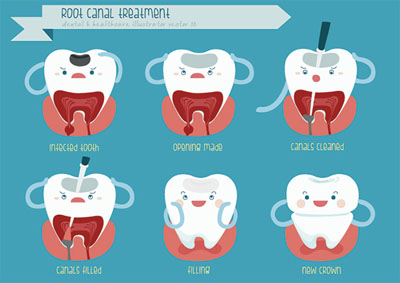Do I Need an Apicoectomy if My Root Canal Does Not Work?

With a root canal, a dentist or endodontist can eliminate pain and save the patient’s permanent tooth; Two great accomplishments. Although dental professionals do everything they can before resorting to this procedure, patients typically handle it quite well. A root canal has a high rate of success for the millions of people who have it performed each year. However, there are times when it does not help.
What is an apicoectomy?
In rare cases, a root canal does not work. When that happens, a dentist may recommend the patient have an apicoectomy. Also referred to as “root end surgery,” this is the procedure a dentist typically chooses if an infection develops or continues following a root canal. Ultimately, dental professionals use this method to try to save the patient’s natural tooth when other remedies fail.
How is an apicoectomy performed?
For an apicoectomy, a dentist or endodontist first numbs the gum area with local anesthesia. Next, the dental professional makes an incision along the gumline near the diseased or damaged tooth. That allows them to reach the infected or inflamed tissue to remove it. At the same time, they remove the tip of the tooth’s root. Next, the dentist seals the end portion of the root canal. After suturing the incision, the bone begins to heal around the root end, which usually takes a couple of months.
Is an apicoectomy painful?
The attending dentist or endodontist numbs the infected area around the tooth. Therefore, the only pain the patient feels is the prick of the needle. For severe cases, the dentist applies a numbing medicine first, which helps reduce this discomfort. When an infection is extremely bad, the dental professional may opt to perform the surgery under general anesthesia.
Compared to a conventional root canal, an apicoectomy involves a little more work. For that reason, it is common for patients to experience either pain or discomfort after returning home. However, the dentist can prescribe pain medication or recommend something over-the-counter. That along with rest and ice to reduce swelling helps tremendously.
A positive option
Seldom does a root canal fail. When someone does not have pain checked by a dentist, the problem only worsens. At some point, a tooth becomes diseased or damaged, which includes an infection. As a result, filling a simple cavity is no longer a viable option. Instead, the dentist would perform a root canal. However, if that does not help, patients have another surgical option in the form of an apicoectomy.
People need to see this as something positive. The reason is that like a root canal, an apicoectomy can save permanent teeth — dentists’ ultimate goal. With natural teeth, people never experience issues with talking or chewing. Avoiding implants and dentures is also more cost-effective for the patient. Therefore, having this second form of oral surgery available is a good thing.
See a dentist about a root canal or an apicoectomy
As soon as you start to develop pain in one of your teeth, see your dentist right away. That gives them the opportunity to fill a small cavity or stop a minor infection. Otherwise, you could find yourself needing a root canal. If that fails, your dentist would likely suggest an apicoectomy. When it comes to your teeth, it is always better to act quickly rather than wait.
Request an appointment here: https://www.southgatefamilydentistry.com or call South Gate Family Dentistry at (323) 583-1481 for an appointment in our South Gate office.
Check out what others are saying about our services on Yelp: Read our Yelp reviews.
Recent Posts
The function of a dental bridge is to literally bridge the gap left after a tooth is lost or extracted due to damage or infection. This tooth replacement option offers a natural-looking and durable solution for many patients. This article answers some frequently asked questions about dental bridges.A dental bridge is made up of two…
Inlays, onlays and dental crowns are most commonly used in general dentistry, but many individuals are exploring them for Cosmetic Dentist purposes. Cosmetic dentistry aims to improve the form and function of teeth that are in bad shape, whether due to accidental damage or long-term complications from cavities or infections. Through inlay, onlay and crown…
Two main goals of Full Mouth Reconstruction are to replace missing teeth and restore the health and appearance of damaged teeth. While many patients may realize they could benefit from dental treatment, some are too concerned that the process is invasive or expensive, which, unfortunately, leads many not to seek treatment. Full mouth reconstruction is ideal…
If you are concerned with discoloration of your teeth, then you may benefit from professional teeth whitening. It is a safe, effective, and quick way to remove minor to moderate stains on teeth and make teeth whiter. Understanding what to expect and how long the results last can help you determine whether treatment is appropriate.The…


